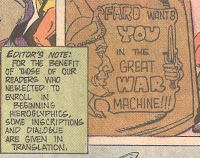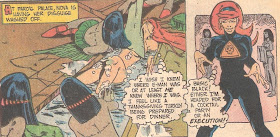by Jack Seabrook
E-Man and Nova are in Egypt! Nova knocks 'em dead at a dance club, but her real purpose is to get a map to a lost city. Mr. Bogni gives her the map at the cost of his life; E-Man appears as the god Ra and stuns the killers with a power bolt.
E-Man and Nova follow the map and find the lost city. Once inside, they discover futuristic machines built five thousand years ago! The city's central tower is a time machine, and our heroes travel back to 3000 B.C., where they find an Egyptian city ruled by fear.
Ramis, the dethroned ruler of Naab (the ancient city), explains that his people came from another star to escape oppression. On Earth, they experienced a plague and blamed Ramis. E-Man and Nova darken their own skin in order to pass as Naabians.
E-Man discovers that the plague that has haunted the Naabians is carried by fleas on pets given to the children by the evil Faro. He warns the people, and Ramis regains control after Faro becomes infected by the very plague he had set upon his fellow Naabians.
 |
| Nova is going far afield to earn money for college! |
 |
| I see a Gil Kane influence here. |
"City in the Sand" is a sixteen-page story with much to recommend it. The splash page is a treat, as it is the first time we have actually gotten a glimpse of one of Nova's performances. The humorous touches continue, with signs all over the lost city urging Naabians to join the "Great War Machine."
 Joe Staton's art is excellent, as usual, and has a hint of Gil Kane in some of the facial angles. Nova never looked better. Near the end of the story, at Faro's palace, she is bathed and dressed in a skintight black costume, which only serves to accentuate her superb figure.
Joe Staton's art is excellent, as usual, and has a hint of Gil Kane in some of the facial angles. Nova never looked better. Near the end of the story, at Faro's palace, she is bathed and dressed in a skintight black costume, which only serves to accentuate her superb figure. |
| Staton must have loved drawing Nova! |
The letter column is replaced this issue by a full-page letter reprinted from "Fantastic Science Fiction and Fantasy Stories." This letter is addressed to science fiction fans, and it talks about E-Man, praising its satire of science fiction tropes.
The backup story is another Killjoy tale by Steve Ditko. Much like the prior one in E-Man 2, this is an almost incomprehensible mess in which Ditko criticizes liberal ideas of how to deal with criminals. The art is not bad, but the storytelling is terrible and so many panels are clogged with dialogue balloons that the artwork is overwhelmed.
 |
| A typical Killjoy panel. |
This issue has a cover date of August 1974. While the indicia says it was published bimonthly, the first four issues have been dated October 1973, December 1973, June 1974 and August 1974. Issues one and two were 20 cents; the price went up to 25 cents with issue three. Oddly enough, issues three and four also feature a cover price of "UK 6p," perhaps anticipating big sales in England. Subscriptions were $1.20 a year at 20 cents a copy, then $1.25 a year at 25 cents a copy. I recall ordering a subscription directly from Charlton because these comics were so hard to find on the newsstand.
 |
| E-Man or Plastic Man? |
One more thing to note about this issue is the influence of the Ancient Astronaut craze that hit in 1968 when Erich von Daniken's Chariots of the Gods was published. This idea had a significant influence on Marvel comics mythology and here it pops up in E-Man as well. One of the fun things about reading the E-Man series is to see what was on peoples' minds in the 1970s.


Professor Jack!
ReplyDeleteDid your mom write a check for $1.20 for that subscription or did you trust your mailman and Charlton with coin?
It's quite possible I went to the post office and got a money order! Remember those? I also once bought a super 8 film from Blackhawk on the installment plan. The total cost was about $10 and I would send $1 a month. I found a $20 bill on the ground during a school field trip to a nuclear power plant (you can't make this stuff up) and was able to pay off the balance early.
ReplyDelete